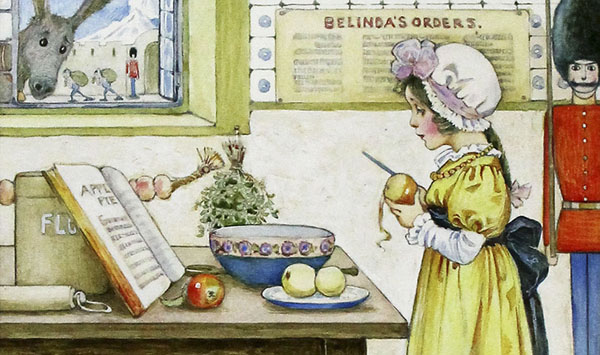Millicent Sowerby’s illustrations for “Childhood”
Painter and illustrator Millicent Sowerby was born in 1878 in Gateshead to a wealthy glass-making family. Her father, John G. Sowerby, as well as acting as director of the glass-making factory, also enjoyed recognition as a painter and illustrator. Millicent was one of the first women to illustrate Lewis Carroll’s Alice in Wonderland, and she also illustrated children’s books by her sister Githa.
Millicent moved to London with Githa in the early 1900s, and the pair began work on their books, Githa writing them and Millicent illustrating them. We at Lucius Books are fortunate enough to have acquired seven beautiful, original illustrations for one such book, Childhood, the sisters’ second book, a collection of children’s verse published in 1907.
Githa also wrote plays, and her most famous, the deeply political play Rutherford & Son (written under the deliberately genderless name of K. G. Sowerby) became a critically acclaimed sensation in London and was subsequently performed in New York. The eventual discovery that the play was written by a woman was met with shock and disbelief, and even withdrawals of praise by some critics. Sadly, the play eventually fell into obscurity before its slow but steady revival in the 1980s, and there is now a growing interest in Githa’s life and work as northern-born, political, feminist thinker and writer.
Millicent’s style was strongly influenced by Kate Greenaway, and her idyllic scenes of sweetly dressed children and tranquil domestic life fitted perfectly into the popular genre of Edwardian children’s gift books. The illustrations for Childhood are highly worked with a very fine attention to detail and an accomplished command of colour. Millicent is adept at creating smoothly blended planes of colour on a dress or a face that contrast against more textured areas built up with tiny brushstrokes to indicate hair, grass, or rough wood. A favourite of mine shows a domestic scene in which a mother works on embroidery whilst glancing affectionately at her child who is writing with a quill. The skilful diagonally trailing composition which flows from the child’s feet up to the top of the mother’s head and the subtle use of muted colours create a harmonious, tranquil picture.

A detail of ‘Apple Pie’, from Childhood.
Original Sowerby works are very rare due to the fact that following Millicent’s death in 1967 one of her nieces while clearing out her aunt’s belongings burned her painting and drawings, believing them to be of no use or value. I feel very lucky to have been able to enjoy these precious, surviving paintings, which are beautiful in their own right and are also wonderful historical artefacts relating to a fascinating family.

‘His Book’ and ‘In Church’, from Childhood.
I would like to thank Pat Riley, Githa Sowerby’s biographer, for providing the photograph of Millicent and also for her invaluable research into Githa Sowerby and her family. Millicent’s portrait, along with many more photographs and much more information, can be found in her book Looking For Githa, the second edition of which is published by Stairwell Books, York.
Find our Sowerby illustrations here.

